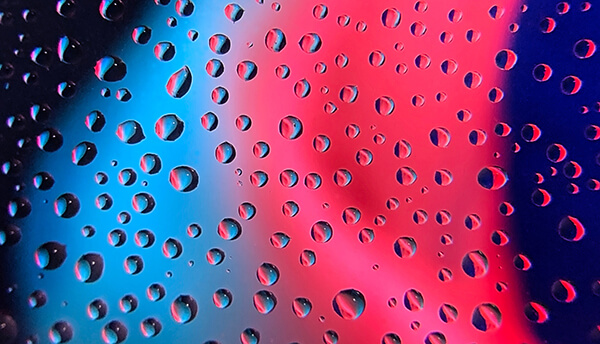How to Choose a Nanocoating Material

Benjamin Lawrence | April 28, 2021
As engineers, it is our job to bring products to life and ensure they operate as expected until the end of product life cycle. Therefore, a large part of our job is to prevent premature failure by providing electronic products with appropriate protection from environmental threats that can cause an immediate or unplanned shutdown. To do this, we need to evaluate protective solutions and sometimes think outside the box. We may need to rethink protection in a landscape punctuated by miniaturization, ruggedization, and sustainability concerns. Nanocoating technology can often address these needs better than current methods like gasketing, protecting products from liquid damage, and its subsequent harm to business reputation.
Hydrophobic Nanocoatings to Improve PerformanceWork
Protective nanocoatings are thin films of coating material measured in thicknesses of nanometers applied directly to the surface of PCBAs and other components or materials. With nanocoatings, product design teams can meet many objectives, including material hydrophobicity (water repellent ) due to the low surface energy of the coating. This may be important for a wide range of applications, like increasing the water resistance of electronics, helping your down sleeping bag stay dry, or allowing water to more easily bead off car windshields. Other protective capabilities that nanocoatings provide include corrosion protection, hardness, or sometimes, oleophobic properties (oil repellent).
In order to effectively apply hydrophobic coatings of this caliber, vacuum deposition is required to ensure the quality and consistency of the application. Plasma enhanced chemical vapor deposition (PECVD) is a popular coating process because it is flexible, controllable, and appropriate for a wide variety of applications. PECVD utilizes plasma, a high-energy, gaseous state that enables material to deposit onto substrates. The process parameters vary tremendously and may include power, plasma type, temperature, deposition time, pressure, gas flows, and gas composition. Adjustments to these parameters makes it possible to produce highly-performing thin films tailored to your protection requirements. Due to the versatility of the PECVD process, a wide range of materials are available to be deposited to help engineer a specific coating solution.
The material you ultimately use for deposition has a close relationship with coating performance, so it is essential to select with care. The criticality of material choice begs the question, how do you choose the best nanocoating material for your project?
Choosing the Right Nanocoating Material
materials (fluorocarbons and chlorocarbons) and halogen-free (silicones, hydrocarbons, metal oxides, and metal nitrides). Ultimately, performance requirements and sustainability concerns will determine which is preferable.
Halogenated Materials
Halogenated material processes produce coatings with high hydrophobicity or strong etching capabilities. Halogen-free material processes, such as silicones and metal oxides, deposit coatings that serve as strong water barriers, offering strong performance.
Halogen-Free Materials
Sometimes non-halogenated materials are preferable for environmental reasons. If you are considering halogen-free materials, the choice does not end there. You’ll have to consider other requirements. For example, metal oxides may provide more substantial protection, but a hydrocarbon coating may provide acceptable performance and is generally easier to handle than other materials.
Understanding the Performance Requirements
While understanding if you prefer halogenated or halogen-free materials will be a critical part of your decision, you must have a thorough understanding of your product’s performance requirements to choose which material to use. Properties such as hydrophobic, hydrophilic, and corrosion resistance will factor into whether a fluorocarbon, silicone, metal oxide, or another material is preferred.

After You Have Chosen a Nanocoating Material
After determining what material type to use, the selected material will determine the precursor (materials that chemically react and/or decompose on the substrate’s surface) and plasma parameters to use. Different gas or liquid precursors result in different coatings. For example, methane may be used as a simple hydrocarbon coating, carbon tetrafluoride for a fluorocarbon, or hexamethyl dioxolane for silicone.
Even after you determined the precursor, the flow rates of that liquid or gas and other parameters can dramatically affect the final coating properties. For example, the addition of oxygen, nitrogen, or argon can completely change the results. Argon is inert in the overall reaction, but it may change the reaction mechanism, which is the sequence of steps that make up the overall reaction. The mechanism affects what film is deposited. Adding oxygen may create oxides, and nitrogen may form nitrides, which add to the film’s hydrophilic properties. Meanwhile, different flows of the same gases may result in different coating properties. Gas flows may range from a few sccm (standard cubic centimeters per minute) to 10,000 sccm or more. This flow rate difference may change the reaction mechanism, altering what is deposited.
With PECVD, there are many options where significant experience and development will be required to understand which materials are best.
Seeking Technical Expertise
As you can see, with PECVD, there are many options where significant experience and development will be required to understand which materials are best. If you are interested in PECVD coating technology and would like help getting started, please reach out today for a consultation.
Benjamin Lawrence
Benjamin is an experienced and enthusiastic engineering consultant with experience in PECVD, thermal CVD, ALD, research, design, operations, mass production, and process development.

Discover how HZO can protect your product
